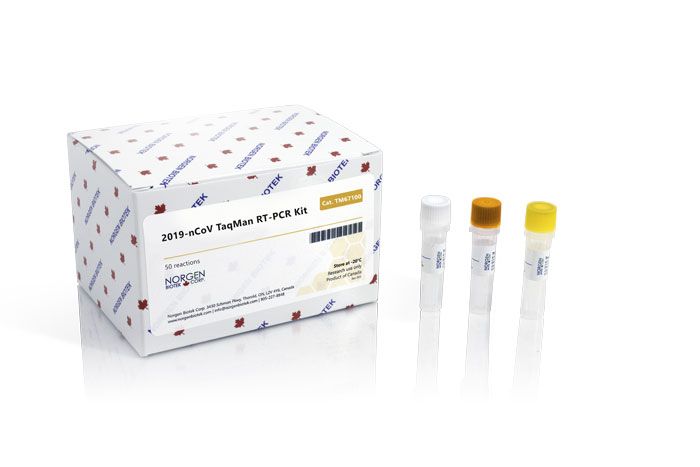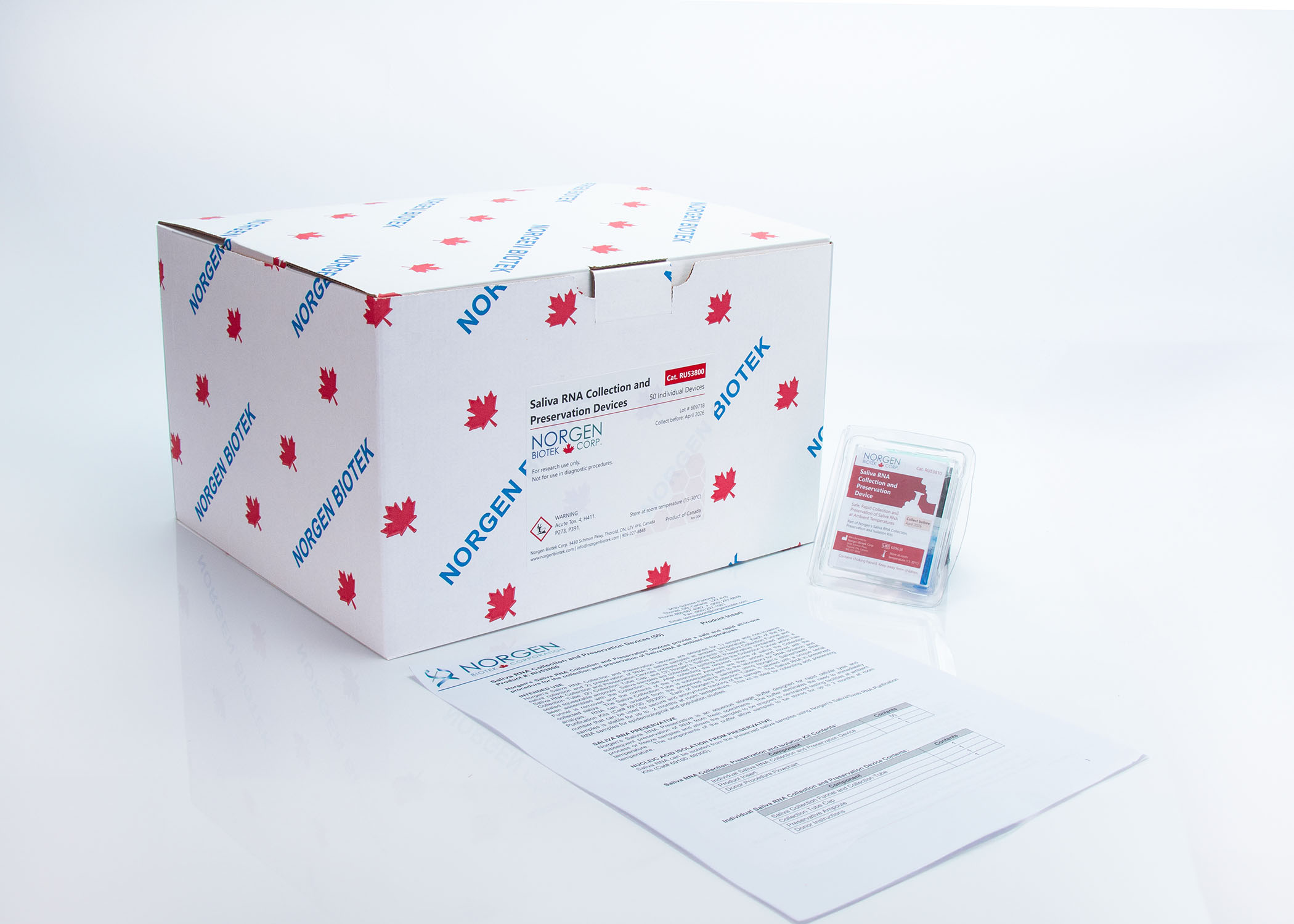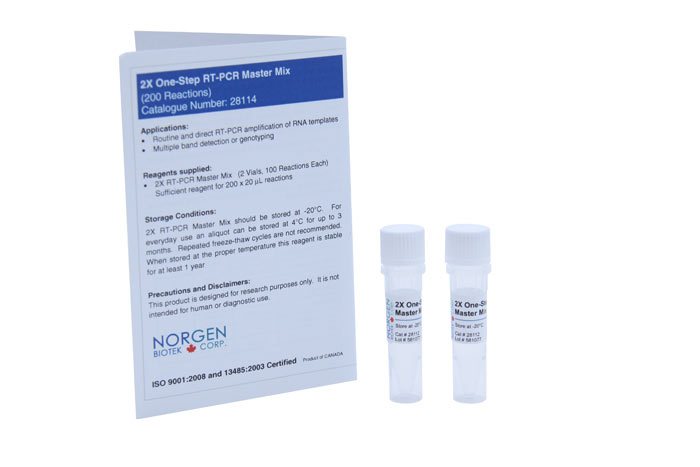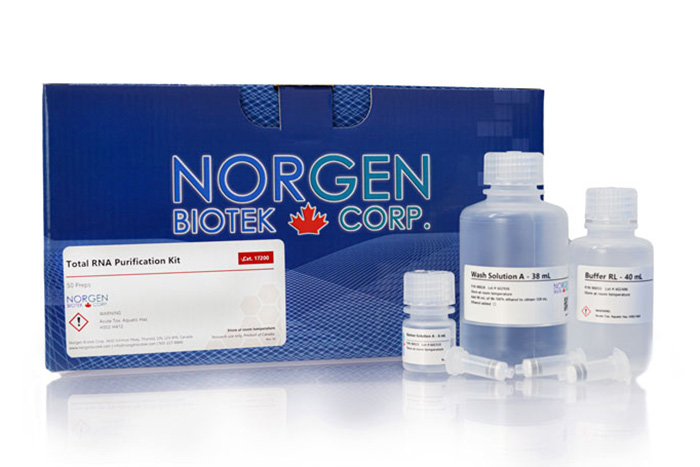2019-nCoV TaqMan RT-PCR Detection Kit

For research use only and NOT intended for in vitro diagnostics.
2019-nCoV TaqMan RT-PCR Detection Kit
Register today to receive an exclusive 15% off* on your first order.
Features and Benefits
- COVID-19 detection based on the assays and protocols
developed by the CDC - Primer & Probe Mixes contain all 3 CDC developed assays in individual tubes
- All assays are premixed to the working concentrations
recommended by the CDC - Positive Control contains 2 nCoV nucleocapsid target gene RNA (N1,N2) and RNase P (internal control) which are compatible with the CDC primer/probe set
- Convenient ready-to-use 2X One-Step RT-PCR Master Mix
- Manufactured under ISO 13485:2016 for research use only
- CE-IVD marked version available
- Find out more information about our complete COVID-19 workflow
Norgen’s 2019-nCoV TaqMan RT-PCR Kit is designed for the detection of SARS-CoV-2 specific RNA in a real-time RT-PCR based on the use of TaqMan technology. This kit is designed for research use only and not for use in diagnostic procedures. The detection of SARS-CoV-2 specific RNA is based on TaqMan one-step RT-PCR providing a simple, reliable and rapid result for the detection of SARS-CoV-2 infection. Norgen’s 2019-nCoV TaqMan RT-PCR Kit includes a PCR control to monitor for PCR inhibition, and to validate the quality of the sample and the detection result. The 2019-nCoV TaqMan RT-PCR Kit comprises Master Mix for the target and PCR control detection, 3 target Primer & Probe Mixes, as well as a positive control and a negative control (nuclease-free water) to confirm the integrity of the kit reagents.
Norgen’s 2019-nCoV TaqMan RT-PCR Kit provides SARS-CoV-2 detection based on the assays and protocols developed by the CDC. The Primer & Probe Mixes contain all 3 CDC developed assays in individual tubes. All assays are premixed to the working concentrations recommended by the CDC. The Positive Control contains two nCoV nucleocapsid target gene RNA (N1 and N2) and RNase P (internal control).
Background information
In December 2019, an outbreak of respiratory illness started in Wuhan City, Hubei Province, China and has now spread throughout the world to many different countries. This respiratory disease was caused by a novel coronavirus and was initially termed “2019 novel coronavirus” or “2019-nCoV”, however in February of 2020 the World Health Organization (WHO) announced that the official name of the disease is COVID-19. The official name of the coronavirus causing COVID-19 is SARS-CoV-2.
SARS-CoV-2 is a new strain of coronavirus infecting humans that had not been previously detected before the outbreak in China in December 2019. While SARS-CoV-2 is new, many coronaviruses have been known to infect animals and humans for some time. Coronaviruses are known to commonly infect camels, cattle, cats, and bats. In humans, Coronavirus infections can cause various illnesses from the common cold to more severe diseases such as Middle East Respiratory Syndrome (MERS) and Severe Acute Respiratory Syndrome (SARS).
Human infection is more severe when the coronavirus has originated in animals and spread to humans, as is the case with MERS and SARS. SARS-CoV-2 is a betacoronavirus, similar to MERS and SARS, both of which have their origins in bats. The animal source of SARS-CoV-2 has not yet been identified, however Chinese officials have linked many of the early cases to a large seafood and live animal market, suggesting that the initial transmission was the result of animal-to-person spread. However, many of the later detected cases did not report any exposure to animal markets, indicating that the virus is now spreading via human-to-human contact.
Symptoms of infection with SARS-CoV-2 can range from milder symptoms such as a runny nose, sore throat, cough, and fever to more severe symptoms including pneumonia or breathing difficulties. In some cases infection with SARS-CoV-2 has resulted in death. As with other respiratory illnesses, older people and individuals with pre-existing medical conditions (such as diabetes or heart disease) are more vulnerable to becoming severely ill with the virus.
Details
Supporting Data
Figure 1. Analytical sensitivity for the detection of 2 SARS-CoV-2 nucleocapsid target genes and the RNase P internal Control target as recommended by the Centers for Disease Control and Prevention (CDC). Panel A represents the 2019-nCoV_N1 target, Panel B represents the 2019-nCoV_N2 target and Panel C represent the RNase P internal Control target. The analytical sensitivity of Norgen’s 2019-nCoV TaqMan RT-PCR Kit was determined by analyzing a dilution series of quantified Norgen’s 2019-nCoV RT-PCR Positive Control (Cat. PC67102) in triplicate (n=3) based on the use of TaqMan® technology. The linear range of Norgen’s 2019-nCoV TaqMan RT-PCR Kit has been determined to detect as low as 2 copies/µL with a confidence ≥ 90%.
Table 1. Operator Reproducibility. Three different operator tested 3 different concentrations in triplicate (n=3) from the 3 SARS-CoV-2 nucleocapsid target genes and the RNase P internal Control using Norgen’s 2019-nCoV TaqMan RT-PCR Kit to assess operator reproducibility. For each test the same kit Lot# and the same PCR instrument was used. The data in Table 1 showing the average Ct. values for the 3 SARS-CoV-2 nucleocapsid targets combined from the 3 different operators.
Table 2. Inter-instrument Reproducibility. Inter-instrument reproducibility was determined by running 3 different concentrations in triplicate (n=3) from the 3 SARS-CoV-2 nucleocapsid target genes and the RNase P internal Control using Norgen’s 2019-nCoV TaqMan RT-PCR Kit across 2 different qPCR instruments. For each test the same kit Lot# was used. The data in Table 2 showing the average Ct. values for the 3 SARS-CoV-2 nucleocapsid targets combined.
Table 3. Diagnostic Accuracy. Clinical evaluation for Norgen’s 2019-nCoV TaqMan RT-PCR kit was assessed by conducting a blind test with 10 different samples being either spiked or non-spiked with Norgen’s 2019-nCoV RT-PCR Positive Control (Cat. PC67102) to determine the Positive Predictive Value (PPV), Negative Predictive Value (NPV), Sensitivity, Specificity and the overall Diagnostic Accuracy.
Storage Conditions and Product Stability
All kit components should be stored at -20°C upon arrival. Repeated thawing and freezing (> 2 x) of the Master Mix, Control Master Mix and Positive Control should be avoided, as this may affect the performance of the assay. If the reagents are to be used only intermittently, they should be frozen in aliquots. All reagents can be stored for 1 year at -20°C without showing any reduction in performance.
| Component | Cat. TM67100 (50 preps) | Cat. TM67120 (500 preps) |
|---|---|---|
| 2019-nCoV_N1 Probe/Primer Mix | 80 μL | 850 μL |
| 2019-nCoV_N2 Probe/Primer Mix | 80 μL | 850 μL |
| RNAse P Probe/Primer Mix | 80 μL | 850 μL |
| 2019-nCoV RT-PCR Positive Control | 50 μL | 500 μL |
| 2X One-Step RT-PCR Master Mix | 2 x 1 mL | 20 x 1 mL |
| Nuclease-Free Water (Negative Control) | 1.25 mL | 10 x 1.25 mL |
| Product Insert | 1 | 1 |
Documentation
Citations
| Title | Diagnostic performance of GENEDIA W and ActiveXpress+ COVID-19 antigens tests among symptomatic individuals in Peru and The United Kingdom |
| Citation | Plos one 2023. |
| Authors | Sandra Palomino-Padilla, Lorna Finch, Margaretha de Vos, Helen Savage, Luz Villa-Castillo, Gail Hayward, Eloise Cook, LSTM diagnostics group, UTB-IMTAvH group, CONDOR steering group, Camille Escadafal. Richard Body, Emily R. Adams, Cesar Ugarte-Gil, Ana I. Cubas-Atienzar |
| Title | Super effective antimicrobial silver-sputtered coatings on poly(lactic acid) against bacteria and omicron SARS-CoV-2 |
| Citation | Materialstoday chemistry 2023. |
| Authors | D.J. da Silva, G.S. Ferreira, A. Duran, F.L.A. Fonseca, R.F. Bueno and D.S. Rosa |



